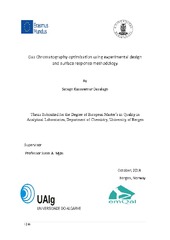| dc.description.abstract | Gas Chromatography (GC) is an analytical method for the separation of enormous range of routine applications, to analyse very complex mixtures of Petroleum, such us different proteins in the human body, and natural products. To achieve good enough separation with reasonable analysis time, optimisation is the best approaching techniques in chromatography. The work is focused to : investigate and optimized extra-column effects, thereafter investigate suitable range of temperature rates in temperature-programmed in 10-60m column length. For isothermal GC, investigate how well different dispersion models fit experimental data, and how the equations change with column length. Pilot study for both oven temperature with condition of 10, 30, 60m were conducted. Main experiment, for PTGC, 25 levels of carrier gases (H_2, He, N_2) velocities, 5 levels of temperature rates and 10-60m column lengths were the variables in the main study. The variables were set with frame reference of pilot study for both oven temperature condition. Same column dimension and 10 levels of carrier gas velocities were the important constraint for isothermal GC. For the optimization of chromatographic conditions, experimental design and response surface methodology, Chrombox C and D were employed. Split ratio (1:200), asymmetry (≤ 1.25ng), starting temperature (PTGC, 60°C), oven temperature (isothermal, 210°C) sampling frequency (>10Hz) and make up gas flow rate (40mL/min) are the conditions which were investigated and set values for pilot and main studies. In isothermal GC, five dispersion models for plate height were calculated, in six different capillary column lengths with different level of pressure drop. Depends on the value of Overall R^2 and RMSE, Golay model with interim pressure drop is good fit models of plate height; irrespective of column dimension and carrier gas. In PTGC, 10°C per void time is claimed to give optimal rates for a given capillary column. The relevance of the advice was compared to the data from this work by calculating PPC/t_topt for the five rates for each column (10-60m). From the relationship PPC/t_topt and ratelength, all the relationship is increasing in all cases and there is no maximum in PPC/t_topt is found within the conditions tested. Although the development in PPC/t_topt seems similar for all columns and carrier gases, the proposed optima are very different. In the same ratelength and for all carrier gases, the performance of column length in every 10m transition was evaluated for isothermal and PTGC. For PTGC, when we shift from 40 m to 50 m, 50 m to 60 m are the transition where maximum 0.4% and minimum 0.3% PPC/t_topt values are observed respectively. Switching off carrier gas, for all employed column lengths (10m-60m), helium by hydrogen, nitrogen by helium the efficiency will be increased by 7.3%, decreased by 16.2% respectively. On the contrary, the time required for the analysis, for the above switching off carrier gases, are decreased by 5.4% and increased by 9.8% while in isothermal the efficiency is increased not more than 4.13%. Carrier gas transition effect (analysis time) in isothermal is much more significance than programmed temperature but the efficiency is dominated in programmed temperature. Column cut off deviation is measured since we used by cutting off single 60m column length. Highest deviation (12%) is recorded in the last cut off 10m while the lowest (2%) is in the first cut off in every 10m nominal length (60-10m). | en_US |
